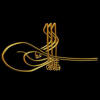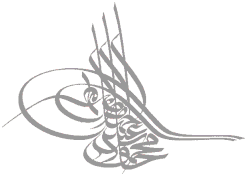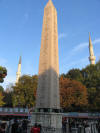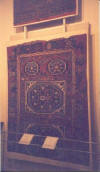| |
Turkish Museums: Turkish and Islamic Arts Museum
 The Turkish and Islamic Arts Museum (Turkish: Türk ve İslam Eserleri Müzesi) is
a museum located in Sultanahmet Square in Eminönü district of
Istanbul, Turkey.
Constructed in 1524, the building was formerly the palace of İbrahim Pasha1, who
was the first grand vizier to Suleiman the Magnificent. The Turkish and Islamic Arts Museum (Turkish: Türk ve İslam Eserleri Müzesi) is
a museum located in Sultanahmet Square in Eminönü district of
Istanbul, Turkey.
Constructed in 1524, the building was formerly the palace of İbrahim Pasha1, who
was the first grand vizier to Suleiman the Magnificent.
The collection includes notable examples of Islamic calligraphy, tiles,
ceramics, metalwork, woodwork, miniatures and some of the oldest
rugs in the
world as well as ethnographic displays on various cultures in Turkey,
particularly of nomad groups. These displays recreate rooms or dwellings from
different time periods and regions.

The Ibrahim Pasha Palace located
around four big internal courtyards has been made of stone in
contrast with many Ottoman civil buildings, most of which are
wooden. It could therefore reach today. However, it has been
renovated between 966 - 1983 and now functions as the Turkish and
Islamic Arts Museum. The museum is the biggest ceremony hall of the
palace and the 2nd courtyard surrounding it displays relevant
Ottoman miniatures, gravures and tables of Western artists.

Turkish and Islamic Arts Museum has
been awarded with the Special Jury Award of Museum of the Year
Competition of the European Council in 1984 and with the prize given
by European Council UNESCO.



Turkish and Islamic Arts Museum is
acknowledged to be one of the most important museums in the world;
displaying all periods and all types of Islamic art with collections
exceeding forty thousand art works. The Museum consists of a number
of divisions:



The carpet
section has the richest collection of carpet art in the world; it is
considered as a "Carpet Museum". The museum has the richest carpet
collection of not only Turkey, but also of the world. Besides rare
Seljuk carpets, prayer rugs and animal figured carpets belonging to
the 15th centuries and the
carpets produced in Anatolia between the
15th - 17th centuries and called as "Holbein Carpet" in the West
inspired by the geometrically figures or kufi writing are the most
valuable parts of this section.


Turkish and
Islamic Arts Museum carpet collection includes also nice famous Uşak
and palace carpet samples as well as Iranian and Caucasian rugs.
Top
Various samples
of Koran displayed in the museum constitute a big part of the
writing collections covering the time periods of [7th century-20th
century] and represent the large geographical Islamic regions of
the world.

It is one of the
superb collections in which the Emevi, Abbasi, Egypt and Syria Tulunoğulları,
Fatımi, Eyyubi, Memluk, Moğol, Türkmen, Seljuk, Timuri, Safavi,
Kaçar and Anatolian Principalities and the Ottoman calligraphy creations
can be observed and worked out sequentially.
Among the hand
writings, except Korans, there are books (some of them with
pictures) written about various subjects and these draw attention
both in terms of their writing styles and their coatings.
Imperial edicts,
warrants bearing the signatures of Ottoman sultans, the sultan's
signatures each of which is a work of art, Turkish and Iranian
miniature writings make Turkish and Islamic Works Museum one of the
most important museums of the world. Top
The most
important parts of this collection are the samples of Anatolian Wood
art of the 9th - 10th century. Besides the unique parts that
remained from the Anatolian Seljuks and principalities, mother - of
- pearl, ivory, tortoiseshell ornamented wooden works of the Ottoman
Period, unique samples of inlaying art, Koran part cases, book
rests, drawers are the interesting parts of this rich collection.
Top
Stone works
belonging to Emevi, Abbasi, Memluk, Seljuk, Ottoman periods, some of
which have motifs and some of which have figures, but all of which
have writings have been gathered in Turkish and Islamic Works
Museum. Unique and elite samples of stone art of Seljuk Period,
grave stones on which hunting scenes, fairy creatures such as
sphinx, griphon, dragon, early - period stone works with kufi
writings, inscriptions written in different methods that are
projections of Ottoman calligraphy art are important both in quality
and in quantity. Top
In this
collection consisting mostly of the ceramic works found in the
excavations made between 1908 -1914, the ones from Samarra, Rakka,
Tel Halep, Keşan are in the first ranks.
It is possible to
see the stages of Early - Islamic Period ceramic art in the
collection of Turkish and Islamic Works Museum. The mosaic, mihrab
and wall encaustic tile samples belonging to the Anatolian
Principalities and Seljuk Periods and the plaster ornaments of Konya
Kılıçaslan Palace constitute another important part of the
collection. Ottoman encaustic tile and ceramic art samples end with
near - period Kütahya and Çanakkale ceramics.
The glass
collection starts with the 9th century Islamic glass art samples and
includes the 15th century Memluk candles, Ottoman period glass art
samples. Top
Turkish and
Islamic Works Museum Metal Art Collection starting with the unique
samples belonging to the Great Seljuk Empire period and mortar,
censer, long - spouted ewer, mirror and dirhems constitute an
important collection with the door knockers of Cizre Ulu Mosque and
the 14th century candelabrums ornamented with constellation and
planet symbols, which have an important place in Islamic metal art.

Among the Ottoman
metal art samples starting from the 16th century and reaching the
19th century, there are silver, brass, tombac (ornamented with
valuable stones) crests, candles, rose water cans, censers, washtub
/ ewer sets. Top
Ethnographic
articles displayed represent a wide range of cultures and time frame
of Ibrahim Pasha Palace (Museum). The displays consist of carpet -
kilim looms collected from various regions of Anatolia, wool
painting techniques, public weaving and ornamenting art samples,
clothes in their regional enhancements, house goods, hand arts, hand
art instruments, nomad tents, etc. Top

İbrahim Pasha(1)
Pargalı İbrahim Pasha or Frenk İbrahim Pasha was the first Grand Vizier
appointed by Suleiman the Magnificent of
the Ottoman Empire (reigned 1520 to
1566). In 1523, he replaced Piri Mehmed Pasha, who had been appointed in 1518 by
Süleyman I's father, the preceding sultan Selim I, and remained in office for 13
years, till 1536, during which time he attained a level of authority and
influence rivalled by only a handful of other
grand viziers of the Empire.
Greek by birth, born in the town of Parga, he was sold as a slave at the age of
six to the Ottoman palace for future sultans situated in
Manisa in
Western
Anatolia. There he befriended Suleiman who was of the same age, and later, upon
Suleiman's accession, was awarded various posts, the first being falconer to the
Sultan. He was so rapidly promoted that at one point he begged Suleiman to not
promote him too rapidly for fear of arousing jealousy. Pleased with this display
of modesty, Suleiman purportedly swore that he would never be put to death
during his reign. Later, after being appointed Grand Vizier, he continued to
receive many gifts from the sultan, and his power in the Ottoman Empire was
absolute, just as his master's. Amongst many titles, he was also unofficially
known as "the most beautiful man in the empire".
Although he married Süleyman's sister and was as such a bridegroom to the
Ottoman dynasty (Damat), this title is not frequently used in association with
him, possibly in order not to confuse him with other illustrious grand viziers
who were namesakes (Damat İbrahim Pasha (a Bosniak) and Nevşehirli Damat İbrahim
Pasha (Turkish). He is usually referred to as "Pargalı İbrahim Pasha" or "Frenk
(the European) İbrahim Pasha" due to his tastes and manners. Yet another name
given by his contemporaries was "Makbul Maktul (loved and killed) İbrahim
Pasha".
His magnificent palace still standing in İstanbul is called Turkish and Islamic
Arts Museum. Attribution of Slavic, Italian (more precisely Genoese) or even
Albanian or Jewish origins to this accomplished polyglot, mainly of speculative
value, have been put forth [1], but many clues referring to his period of power,
such as the fact that he chose to build his palace in immediate view of
Atmeydanı (today Sultanahmet Square) in İstanbul (the famed Hippodrome of the
Byzantine emperors, facing Ayasofya), clearly indicate that he was Greek. Built
according to a design which is unmistakably defensive in concept (he had
fearsome rivals), his palace is the only residence built by someone outside the
Ottoman dynasty that deserves to be designated as a palace.
On the diplomatic front İbrahim's work with Western Christendom was a complete
success. Portraying himself as "the real power behind the Ottoman empire",
İbrahim used a variety of tactics to negotiate favorable deals with the leaders
of the Catholic powers. The Venetian diplomats even referred to him as "İbrahim
the Magnificent", a play on Suleiman's usual sobriquet. In 1533, he convinced
Charles V to turn Hungary into an Ottoman vassal state. In 1535, he completed a
monumental agreement with Francis I that gave France favorable trade rights
within the Ottoman empire in exchange for joint action against the Habsburgs.
This agreement would set the stage for joint Franco-Ottoman naval maneuvers,
including the basing of the entire Ottoman fleet in southern France (in Nice)
during the winter of 1543.
A skilled commander of Suleiman's army, he eventually fell from grace after an
imprudence committed during a campaign against the Persian Safavid empire, when
he awarded himself a title including the word Sultan. This incident launched a
series of events which culminated in his execution in 1536, thirteen years after
having been promoted as Grand Vizier. It has also been suggested by a number of
sources that Ibrahim Pasha had been a victim of Hürrem Sultan's (Roxelana, the
sultan's wife) rising influence on the sovereign, especially in view of his past
support for the cause of Sehzade Mustafa, Suleiman I's first son and heir to the
throne, who had been strangled to death by his father on 6 October 1533, through
a series of plots put in motion by Roxelana.
Since Suleiman had sworn not to take Ibrahim's life during his reign, he
acquired a fetva, which permitted him to take back the oath by building a mosque
in İstanbul. He announced the fetva one week before İbrahim's execution and
dined alone with him seven times before the final move, so to give his life-long
friend a chance to flee the country or to take the sultan's own life. It was
later discovered in İbrahim's letters that he was perfectly aware of the
situation but nevertheless decided to stay true to Suleiman.
Suleiman later greatly regretted İbrahim's execution and his character changed
dramatically, to the point where he became completely secluded from the daily
work of governing. His regrets are reflected in his poems, in which even after
twenty years he continually stresses topics of friendship and of love and trust
between friends and often hints on character traits similar to Ibrahim's.
Top
|
|

















